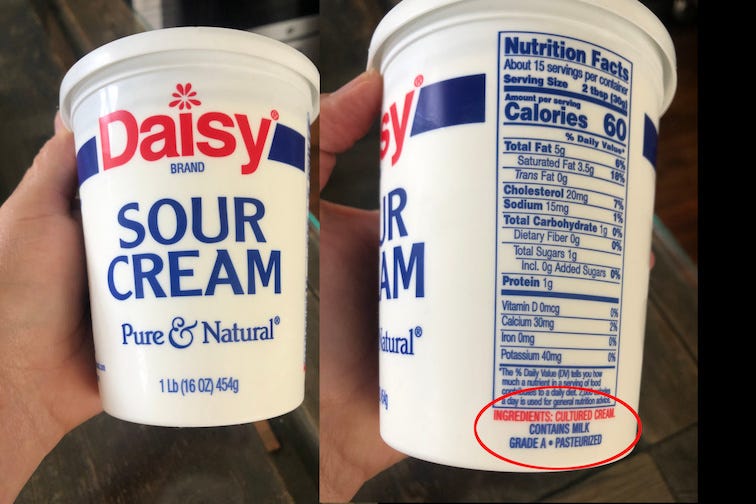What really does a body good
Food fantasy meets food reality.
Whether it’s the pressure to turn your morning latté into a hemp-oat-soy-coconut or take-your-pick-of-nut milks concoction in the name of the planet, or the admonition to avoid dairy as a weight-loss maneuver, milk has taken a severe beating over the past fifty years. So much so that the milk industry once resorted to dramatic campaigns to cast milk in a sexier light, to literally put milk on the lips of countless celebrity icons.
But why? Is milk really bad for you? What ever happened to the idea that milk was necessary to build strong teeth and bones? Doesn’t milk “do a body good” anymore?
A few years ago, I finally got a correct diagnosis after an always frustrating, many-decades-long search for a solution to chronic health issues. Since early childhood, I’d dealt with near-constant food reactions, and the bulk of that happened in the seventies and eighties when we did not have the culture of extreme accommodation we have now, so it was usually, “Eat your supper, Lisa. There are children starving in Africa who would love to have it.”
Of course my parents weren’t going to take my advice and send my dinner plate to Kenya, so I just got sick a lot. An enduring theme from my report cards was, “Student held back by too many absences.”
Once I hit adulthood and gained control over my own meals, I tried many different diets in order to get relief, since the medical establishment had only drugs and more drugs to offer, none of them effective. Every diet hawker had something to say about dairy. It was never good.
Always one to embody a nineties cliché, as soon as I left home for college, I became a vegetarian. But unlike many of my Gen X brethren, I wasn’t just flirting with the diet; I kept at it for a full 13 years, and for the majority of that time, I was a vegan. When I eventually returned to meat-eating (practically kicking and screaming, and only due to a health crisis), I tried dairy-free diets alone, as well as the Whole 30 diet (which has you eliminate milk). None of these did the trick. Every single one of these diets actually made me sicker.
It has been 100 percent the alternative health-care providers in my life—the herbalists and acupuncturists—who’ve been quickest to render anti-dairy judgment. But well-meaning family and friends have been guilty of anti-milk evangelism as well, especially women. Ironically, considering how important calcium is for bone health, women seem to have particularly embraced an aversion to cow’s milk. Many of the women I know are either avoiding dairy altogether or severely limiting it in their diets. (At least back on the West Coast—this is less true here in the Midwest.)
Now that I’ve been down the rabbit hole on this whole milk issue, I can see how totally misguided the anti-dairy assumptions are, though I do understand where they come from.
One of the reasons we’ve shied away from milk is due to the excesses of the industry itself, the reports of growth hormones and antibiotics making their way into our milk cartons. This is the result of the often inhumane conditions at large-scale dairies, more accurately called confined animal feedlot operations (CAFOs). In the name of greater production and cost-efficiency, dairy cows are sickened both by their unnatural living conditions in the CAFO and their inappropriate diets, thus the need for antibiotics. That’s enough to make anyone reach for the soy milk instead.
In lactose-intolerant people, dairy can be a real problem. My husband, Anthony, and our son, Zander, are both slightly lactose-intolerant; it’s not an either/or question but rather a matter of degree, as 90 percent of the global population has inherited at least some ability to digest milk.
One of the reasons I clung to veganism so long despite obvious negative health outcomes is because I completely bought into the ideology that it is somehow ‘unnatural’ to drink the lactation of another mammal. That ideology only works, however, for those of us who are cut off from the collective history of living close to the land, in tandem with the animals we’ve domesticated and that have evolved with us.
That’s right, evolved. Around 10,000 years ago, livestock-raising peoples in several different locations on the globe—independently of one another—developed a genetic mutation enabling them to produce lactase in adulthood; before this it had only functioned in childhood, to allow babies to digest mother’s milk.
This was a game-changer for humanity, one that helped us better survive famines and might have given rise to civilization itself. Dairy cows can transform grass pasture—which humans cannot digest, since we do not possess the rumens bovines do—into high-quality, high-calorie protein, vitamins, and minerals.
The Mayo Clinic advises both vegans and the lactose intolerant to take calcium supplements, with the caveat that the best way the body absorbs calcium is through foods that naturally contain it.
It’s not even true that dairy is a “mucus-forming food,” as many an alt-health provider has tried to tell me. According to the Mayo Clinic, “Milk consumption and phlegm production among people with the common cold in a clinical study showed no increased phlegm associated with drinking milk.”
So now that I’ve knocked down all of those sacred, um, cows, where do we stand?
In my own rather prolonged health journey, what I’ve discovered is that high-quality milk from animals that have been pasture-raised and pasture-fed—when I can find it and afford it—is a far better option for me than any of the milk stand-ins being foisted upon us on all fronts.
Why, you ask? It’s not really the fault of the hemp, soy, oat, or what-have-you, though I do need support (in the form of fermentation, but that’s a story for another day) in order to digest nuts, legumes, and some grains. What really ruins these milks for me is the additives.
Without exception, none of these substances creates a milk with the same viscosity, the same creaminess, as real cow’s milk. So food scientists try to fake it with gels, gums, and thickeners. I challenge you to read the labels of your alterna-milks and find one that doesn’t contain gellan, guar, and xantham gum, or carageenan and the like. Most contain more than one of these, for example this popular hemp milk lists both xantham and gellan gum.
These highly processed foodish substances might start out as something legit (carageenan is a seaweed found in the British Isles), but a) seaweed doesn’t really belong in nut milk, does it? and b) by the time the processing is done, they hardly resemble their original form. Most of these additives are used in both food and non-food products, which is itself cause for question.
It’s not just the thickeners. Plant-based milks also contain a lot of other junk to make them shelf-stable for the long haul. Did you notice that hemp milk above also lists disodium phosphate and tricalcium phosphate as ingredients? These are both straight-up chemicals. You think you’re drinking some pure liquid, what, crushed from hemp seeds? But you’re literally drinking something cooked up in a lab. You know what doesn’t contain chemicals? Cow’s milk.

A word about the substance referred to as “natural flavor.” According to Michael Pollan in the Omnivore’s Dilemma, that’s a highly processed distillate or extract from our vast GMO (mostly corn) food system, and the way the category “natural flavor” is defined, it can actually include chemicals, too. There’s a reason they’re not telling you exactly what the thing is giving it “flavor.”
You might treat me like your personal canary in the coal mine. As someone living with Mast Cell Activation Syndrome, I’ve learned the hard way to avoid all of these additives entirely, as they will give rise to a host of reactions throughout my system, ranging from the immediate (severe heartburn with esophageal convulsions in which I spit up slimy bile, yuck) to the predictable and intermediate (stomach upset), to the delayed (an inflamed bladder and symptoms resembling cystitis, as well as intestinal distress).
Because I’d once wholeheartedly believed in veganism, I’ve tried every single type of alt milk out there, from almond to walnut and everything in between. None of them left me symptom-free. They’re no substitute for real milk, either: Most contain little to no calcium or protein unless they’ve been added as an external input, which as you remember is not the best way to get nutrients.
Now you can search for your alt-milk ingredients online, and you’ll be pushed into top search results that are all pretty much skewed into the narrative that all of these substances are super-safe, trust us! But I ask you this: How do we really know that? What’s the long-term effect of filling our bodies with these chemicals, these so-far-removed-from food foodstuffs day-in, day-out? What if our skyrocketing food intolerances and sensitivities are warning bells? Most importantly: How long can we ignore this?
For the me, the answer is clear: Not. Any. Longer.








Preach it, Lisa! Nothing beats whole, cream top milk. We drink it plain and make yogurt and kefir.
Great piece, Lisa. I love the bottle and the ‘cream on top’ description -- reminds me of childhood when the milkman would leave glass bottles in an aluminum box on the stoop in the pre-dawn hours.